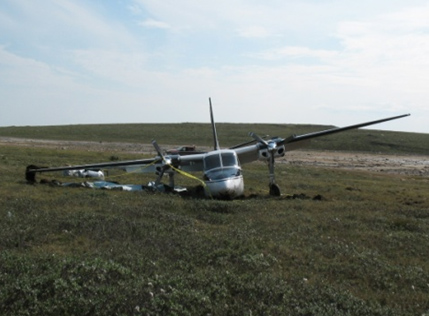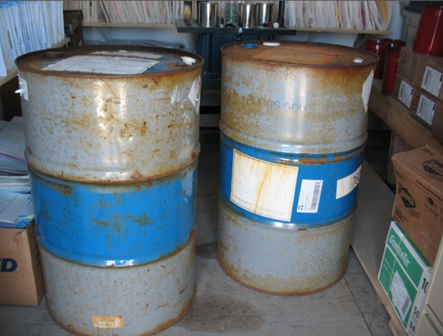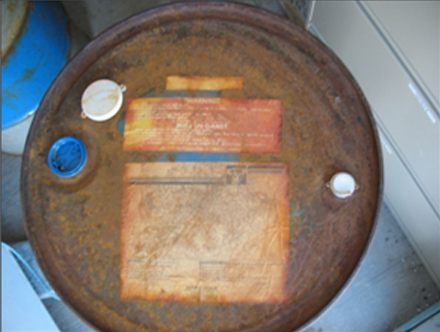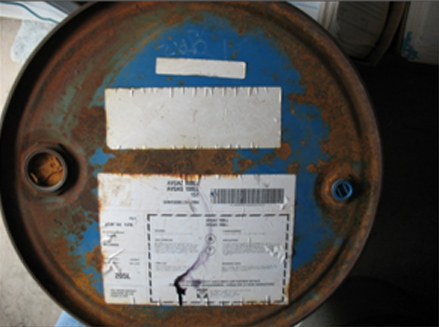Engine Power Loss - Forced Landing
Aero Commander 500S N5800H
Rankin Inlet, Nunavut
The Transportation Safety Board of Canada (TSB) investigated this occurrence for the purpose of advancing transportation safety. It is not the function of the Board to assign fault or determine civil or criminal liability. This report is not created for use in the context of legal, disciplinary or other proceedings. See Ownership and use of content. Masculine pronouns and position titles may be used to signify all genders to comply with the Canadian Transportation Accident Investigation and Safety Board Act (S.C. 1989, c. 3).
Summary
At approximately 1330 Central Daylight Time, the privately-registered Aero Commander 500S (registration N5800H, serial number 3082) departed runway 31 at the Rankin Inlet Airport, Nunavut, with 2 pilots and 1 passenger on board. Shortly after rotation, cylinder head temperatures increased and both Lycoming TIO‑540‑E1B5 engines began to lose power. The pilots attempted to return to the airport, but were unable to maintain altitude. The landing gear was extended and a forced landing was made on a flat section of land, approximately 1500 feet to the southwest of the runway 13 threshold. There were no injuries and the aircraft sustained substantial damage.
Factual information
History of the Flight
The Aero Commander 500S had recently been purchased. The new owner of the aircraft retained the services of 2 experienced pilots to deliver the aircraft from Portland, Oregon, United States, to Bern, Switzerland. After having flown several positioning legs, the aircraft arrived at Rankin Inlet for refuelling.
The aircraft was refuelled from two 45-gallon drums and was to continue on to Iqaluit, Nunavut. The pilot-in-command occupied the right seat and the pilot flying the aircraft occupied the left seat. The aircraft was at its maximum takeoff weight of 7000 pounds. Prior to take off, the crew conducted a run-up and all indications seemed normal. During the takeoff roll, the engines did not produce full power and the crew elected to reject the takeoff. After returning to the ramp, a second run-up was completed and once again all indications seemed normal. The crew then proceeded with a second takeoff.
Weather
The observed weather for Rankin Inlet at 1400 Footnote 1 was as follows: winds 180° True at 5 knots, visibility 15 statute miles, scattered clouds at 27 000 feet above ground level, temperature 17°C and dew point 8°C. The weather conditions were not considered to be a factor in the accident.
Pilots
The pilot-in-command held a U.S. airline transport pilot licence (ATPL) with a valid medical certificate. He had a total of 23 100 hours flying time, including 40 hours on the Aero Commander 500S and 6100 hours on similar Commander aircraft.
The pilot flying held Swiss/JAR ATPL (A) and FAA commercial pilot licenses with a valid medical certificate. He had a total of 5400 hours flying time, which included 13 hours on the Aero Commander 500S.
Aircraft
The Aero Commander 500S is a twin‑engine aircraft approved for both day and night visual and instrument flight rules operations. It is equipped with 2 Lycoming TIO-540‑E1B5 piston engines. The recommended fuel for the aircraft is 100/130 or 100LL grade aviation gasoline.
The aircraft design incorporates 5 fuel cells: 2 in each wing and 1 centre fuel cell. Fuel flows from the wing cells into the centre fuel cell, which, in turn, feeds both engines. In some other twin‑engine aircraft, the fuel in each wing fuel cell remains segregated and is used by the left or right engine, respectively, unless crossfeed is selected.
The aircraft maintenance records indicated that the aircraft had undergone some major modifications, including the installation of turbo chargers and long range fuel cells. Records indicated that the aircraft was maintained in accordance with applicable regulations. A review of the aircraft's weight and balance information indicated that the aircraft was within the prescribed limits during the occurrence.
Aircraft Wreckage Information
As the aircraft came to a rest, following the forced landing, the right landing gear oleo piston failed in overload and the right wing dropped. The aircraft came to a rest in an upright position facing north, with the right wing low (see Photo 1). The entire wreckage trail was approximately 270 feet long. First responders put down some spill blankets under the right wing to absorb fuel leaking from the fuel vents.
The scent of fuel at the site was not characteristic of aviation gasoline. Fuel samples were taken from the centre and right fuel cells. The left fuel cells had only residual fuel remaining and a sample could not be collected. Fuel from the centre and right cells was examined at the site. This fuel and the engine fuel filters exhibited a greasy texture that did not evaporate rapidly. Inspection of the left and right airframe fuel filters revealed an accumulation of debris, the amount of which was not considered sufficient to block the flow of fuel. An inspection of both left and right fuel control unit finger screens revealed no accumulation of debris.
The fuel filters were sent to the TSB Laboratory in Ottawa for analysis. Analysis revealed the debris to be foreign to the fuel system. A visual inspection of all piston heads through the spark plug holes revealed signs of pitting. Further inspection of the airframe and engines did not reveal any pre-impact anomalies.
Emergency Locator Transmitter
The aircraft was equipped with an AMERI-KING AK-451 406MHz emergency locator transmitter (ELT), which did not activate during the impact sequence. The ELT was bench‑tested at an avionics facility and no anomalies were found. The ELT has a single axis G‑switch, which only activates if the impact forces are nearly in the same orientation as the G‑switch axis.
Aircraft Refuelling
Five days prior to their arrival in Rankin Inlet, the crew had placed an order for two 45‑gallon drums of 100LL AVGAS Footnote 2. After landing at the airport, the fuel handler was notified and asked to deliver the drums of 100LL AVGAS. Each 45-gallon drum was delivered separately by the same fuel handler. The drums were similar in appearance (see Photo 2). The first drum was labelled as 100LL AVGAS and both bung plugs had plastic seals on them (see Photo 3). The second drum was picked up by the fuel handler adjacent and in close proximity to the sealed and palleted 45‑gallon drum stock of 100LL AVGAS. Photos taken during the refuelling indicate that the large bung plug of the second 45‑gallon drum of fuel was weathered and did not have a white plastic seal over it (see Photo 4).
The pilots had little experience with refuelling from 45‑gallon drums and assumed that the fuel provided would be of the correct grade. A local air operator provided a Velcon filter-equipped wobble pump and demonstrated to the pilots how to install and use it on the first drum. The pilots checked the fuel in the first drum and found that it appeared to be 100LL AVGAS. They then used the first drum to fuel the centre and right wing fuel cell. The second 45-gallon drum was also labelled 100LL AVGAS. Approximately 30 gallons of the second 45-gallon drum was used to top up the left fuel cell and the remainder of the right fuel cell. Vision, touch and smell were not used to determine the type of fuel in the second drum.
Fuel Handling and Supply
Fuel availability and fuelling procedures can vary significantly from large airports to small northern remote airports. At larger airports, most fuel is available from tanker trucks and fuelling the aircraft is conducted by the fuel handler. The pilot trusts that the correct grade of fuel has been uploaded. At smaller remote airports, certain fuels may only be available in 45‑gallon drums and the pilot must personally refuel the aircraft, as in this occurrence. The pilot is responsible for determining the type of the fuel being supplied. A company supplying aviation fuel for use in civil aircraft is responsible for the quality and specifications of its products up to the point of actual delivery.
The local fuel supplier orders fuel and operates and maintains the fuel storage compound.
AVGAS is not available by tanker truck at Rankin Inlet Airport. The AVGAS is delivered in 45‑gallon drums by the local fuel handler from the local fuel storage compound. The local fuel handler arranges delivery of the drums to the airport, but does not assist in aircraft refuelling.
The fuel storage compound consists of several bulk fuel storage tanks containing jet fuel, diesel and automobile gasoline. The compound also stores 100LL AVGAS in 45-gallon drums. The drums come in 4‑pack configuration that sit on a wooden pallet and are bound together with metal strapping. Each drum is marked as 100LL AVGAS and has a large and small bung plug. The plugs are sealed with a white plastic cap and small aluminum band.
At the time of the accident, the fuel storage compound was undergoing renovations. Old bulk fuel storage tanks were being cleaned and new bulk fuel storage tanks were being constructed. The empty 45‑gallon drums of 100LL AVGAS were used to store residual fuel from the old bulk storage tank pipelines and dirty solvent, referred to as slops. After the drums were filled with slops, they were marked AVGAZ Footnote 3 using a welder's pencil and were stored approximately 200 feet away from the sealed and palleted 45‑gallon drums of 100LL AVGAS. The second 45‑gallon drum used to fuel the accident aircraft had a very faint AVGAZ marking and also had the original 100LL AVGAS markings on it. It was located near the sealed stock of 100LL AVGAS drums.
AVGAS Contaminated with Jet Fuel
AVGAS is a more volatile fuel than jet fuel. AVGAS is less dense, has a low flashpoint and burns at lower temperatures, while jet fuel has a higher flashpoint and burns at higher temperatures. Gasoline piston engine operation relies on combustion to produce engine power. Combustion is a steady rate of burn that, when timed properly, allows the engine to use the fuel's full energy potential. When AVGAS is contaminated with jet fuel, the heat produced by the combustion of the AVGAS component during ignition results in the ignition of the jet fuel component of the fuel mixture. The elevated ignition temperature and further compression causes the critical temperature and pressure inside the combustion chamber to reach a limit where detonation occurs. Detonation is a series of explosions that expend their energy very rapidly. Detonation can begin prior to the piston reaching top dead centre (TDC), which results in an opposing force on the piston. After TDC is reached, the continued detonation does not allow the engine to use the fuel's full energy potential.
Detonation may also induce pre-ignition. Pre-ignition is the ignition of the air/fuel mixture before the spark plug fires. Pre-ignition can be caused by hot spots, glowing spark plug and glowing carbon deposits, which were produced by previous engine combustion cycles. Severe detonation can cause pitting of piston heads.
Fuel Analysis
Following the accident, the local fire department and the Royal Canadian Mounted Police secured both 45‑gallon drums that were used to refuel the accident aircraft. An inspection of the first drum revealed no anomalies with the fuel. The fuel was blue in colour and its odour was indicative of 100LL AVGAS. An inspection of the second 45‑gallon drum revealed that the texture, odour and colour of the fuel were not characteristic of 100LL AVGAS. The bottom of the drum also contained a considerable amount of debris.
Fuel samples were taken from the second 45-gallon drum, centre fuel cell and right fuel cell of the aircraft before being sent to a laboratory for analysis. Analysis of the samples revealed the following:
- The second 45‑gallon drum sample did not comply with the specifications for AVGAS. It appeared to be contaminated with heavier fuel, most likely diesel or jet fuel;
- The centre fuel cell sample did not comply with the specifications for AVGAS. It appeared to be AVGAS contaminated with 30% to 40% heavier fuel, such as diesel or jet fuel; and
- The right fuel cell sample did not comply with the specifications for AVGAS. It appeared to be AVGAS contaminated with 20% to 30% heavier fuel, such as diesel or jet fuel.
The following TSB Laboratory report was completed:
- LP117/2010 – Examination of Fuel Filters & Fuel Analysis Review.
This report is available from the Transportation Safety Board of Canada upon request.
Analysis
Both 45‑gallon drums were similar in appearance and were marked 100LL AVGAS. The second 45‑gallon drum had been located near the fresh stock of 45‑gallon drums of 100LL AVGAS; the fuel handler likely mistook it for a sealed fresh drum of 100LL AVGAS and delivered it to the aircraft. It could not be determined how this drum had been placed in such close proximity to the sealed stock of 45‑gallon drums of 100LL AVGAS.
The pilots were inexperienced in fuelling from 45‑gallon drums. The pilots checked the first drum and found the fuel contained in it to be 100LL (the correct type). They assumed that the second drum also contained 100LL AVGAS and used it to fuel the aircraft.
The fuel system design allowed the fuel from both wing fuel cells to mix in the centre cell and, as a result, contaminated fuel was fed to both engines. The engine run-up was mostly done at lower power settings and limited high power settings. As a result, critical engine temperatures and pressures were not reached and no anomalies were noticed. During the takeoff roll, higher power settings were used for a longer period of time, allowing temperatures to increase. The increased temperatures caused the contaminated AVGAS to detonate and the engines to lose power. After rejecting the takeoff, the pilots returned to the ramp, which allowed the engine temperatures to decrease. As a result, a second run-up was successfully completed and the pilots decided to conduct a second takeoff. The use of takeoff power settings during the takeoff roll and after rotation again resulted in increased cylinder head temperatures and, subsequently, a loss of engine power in both engines. As a result, the aircraft was unable to maintain altitude after takeoff.
After the aircraft came to a rest following the forced landing, the right wing was in a lower position than the left wing. Fuel in the left wing fuel cell began to cross over to the centre, followed by the right wing and vent overboard through the right fuel cell vents, resulting in the depletion of the fuel in the left fuel cell.
The accumulated debris found on the left and right airframe fuel filters likely came from the second 45‑gallon drum. It is unlikely that accumulation of debris on the fuel filters contributed to the engine power loss.
It was determined that the impact force angles were substantially different from that of the G‑switch orientation. As a result, the ELT did not activate during the impact.
Findings
Findings as to causes and contributing factors
- At the fuel compound, the 45‑gallon drum containing slops was located near the stock of sealed 45-gallon drums of 100LL AVGAS, contributing to the fuel handler selecting the drum of slops in error.
- The 45‑gallon drum of slops had similar markings to the stock of sealed 45‑gallon drums of 100LL AVGAS, preventing ready identification of the contaminated drum.
- The fuel handler did not notice that the large bung plug was not sealed on the second 45‑gallon drum and, as a result, delivered the drum of slops to the aircraft.
- The pilots did not notice that the large bung plug was not sealed on the second 45‑gallon drum and, as a result, fuelled the aircraft with contaminated fuel.
- The pilots were inexperienced with refuelling from 45‑gallon drums and did not take steps to ascertain the proper fuel grade in the second 45‑gallon drum. As a result, slops, rather than 100LL AVGAS, was pumped into the aircraft's fuel system.
- The fuel system design was such that the fuel from both wing fuel cells combined in the centre fuel cell and, as a result, contaminated fuel was fed to both engines.
- The contaminated fuel resulted in engine power loss in both engines and the aircraft was unable to maintain altitude after takeoff.
Finding as to Risk
- The impact force angles were substantially different from that of the ELT's G-switch orientation. As a result, the ELT did not activate during the impact. This could have delayed search and rescue (SAR) notification.
Safety Action Taken
The supplier has isolated the sealed 45-gallon drums of 100LL AVGAS from the slops drums by moving the slops drums to the opposite end of the fuel storage compound.
Renovations of the storage facility have been completed with designated storage areas: slops barrel storage is separated from AVGAS barrel storage. The majority of the 45-gallon barrels of slops have since been discarded and the remaining and future slops will be stored in a 100 000 L holding tank.
The pilots have familiarized themselves with refuelling from drums by reviewing a Transport Canada safety publication (TP 2228E-13), Fuel Drum Etiquette.
This report concludes the Transportation Safety Board's investigation into this occurrence. Consequently, the Board authorized the release of this report on .



